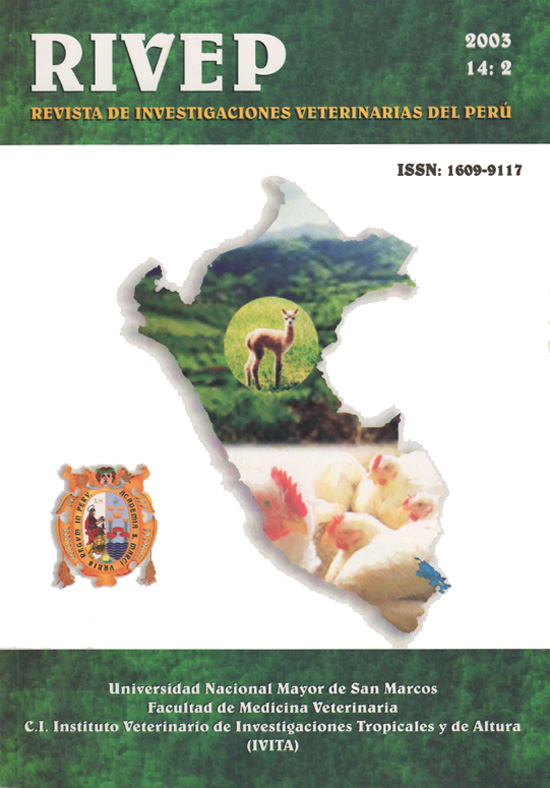USO DE ANTICUERPOS MONOCLONALES PARA CARACTERIZAR TUMORES LINFOIDES AVIARES
DOI:
https://doi.org/10.15381/rivep.v14i2.1616Keywords:
Marek’s disease, lymphoid leukosis, lymphoid tumors, immunofluorescence testAbstract
Macroscopic and histological tests were compared with presence of cell marker tests to better differentiate between Marek’s Disease (MD) and Lymphoid Leukosis (LL) to improve the diagnosis criteria on avian lymphoid tumors. These tests were carried out on 40 laying hens affected with tumors from commercial farms on the North coast of Peru (Trujillo, Lima and Chincha). Initially, using macroscopic criteria (age and affected organ) it was determined that 60% (n=24) were affected from MD and the other 40% (n=16) from LL. Subsequently, presence of infiltrated pleomorphyc lymphocytes in histopathological tests (HP), was a criteria used to determine that 45% (n=18) of the tumors were caused by MD and the other 22 had histological characteristics corresponding to LL (presence of homogeneous lymphoblasts forming nodules). In this way, the direct immunofluorescence test (IF) using monoclonal antibodies (MoAb) that was developed to identify lymphocyte T markers (CD3+), confirmed that only 50% (9/18) of the animals histologicaly diagnosed with MD had transformed T cells. Similarly, the MoAb for lymphocyte B (Ig M+), detected that only 54.6% (12/22) had transformed cells corresponding to lymphocyte B. Surprisingly, in 12/40 hens with nodular lymphoid tumors neither cell T nor cell B markers could be identified and in 9/40 cell markers for both kinds of cell (T and B) were able to be identified in the tumors. Also, in 3/18 and 2/22 of the samples diagnosed histopathologicaly with MD and LL respectively, the presence for myelocites was found suggesting the presence of avian leukosis virus subgroup J. Kappa and McNemar statistic tests showed that for Marek’s Disease had low concordance between HP and IF (-0.045); however, both methods (HP and IF) had a reasonable rate of concordance (0.314) for lymphoid leukosis. It is, concluded that the immunofluorescence test using the cell markers detection for monoclonal antibodies allows a more exact and efficient differential diagnosis than the histopathological test on avian lymphoid tumors. However, the histopathological and the immunofluorescence test are not mutually replaceable.Downloads
Downloads
Published
Issue
Section
License
Copyright (c) 2003 Richard Tasayco A., Raúl Rosadio A., Eliana Icochea D’A., Hermelinda Rivera G.

This work is licensed under a Creative Commons Attribution-NonCommercial-ShareAlike 4.0 International License.
AUTHORS RETAIN THEIR RIGHTS:
a. Authors retain their trade mark rights and patent, and also on any process or procedure described in the article.
b. Authors retain their right to share, copy, distribute, perform and publicly communicate their article (eg, to place their article in an institutional repository or publish it in a book), with an acknowledgment of its initial publication in the Revista de Investigaciones Veterinarias del Perú (RIVEP).
c. Authors retain theirs right to make a subsequent publication of their work, to use the article or any part thereof (eg a compilation of his papers, lecture notes, thesis, or a book), always indicating the source of publication (the originator of the work, journal, volume, number and date).










